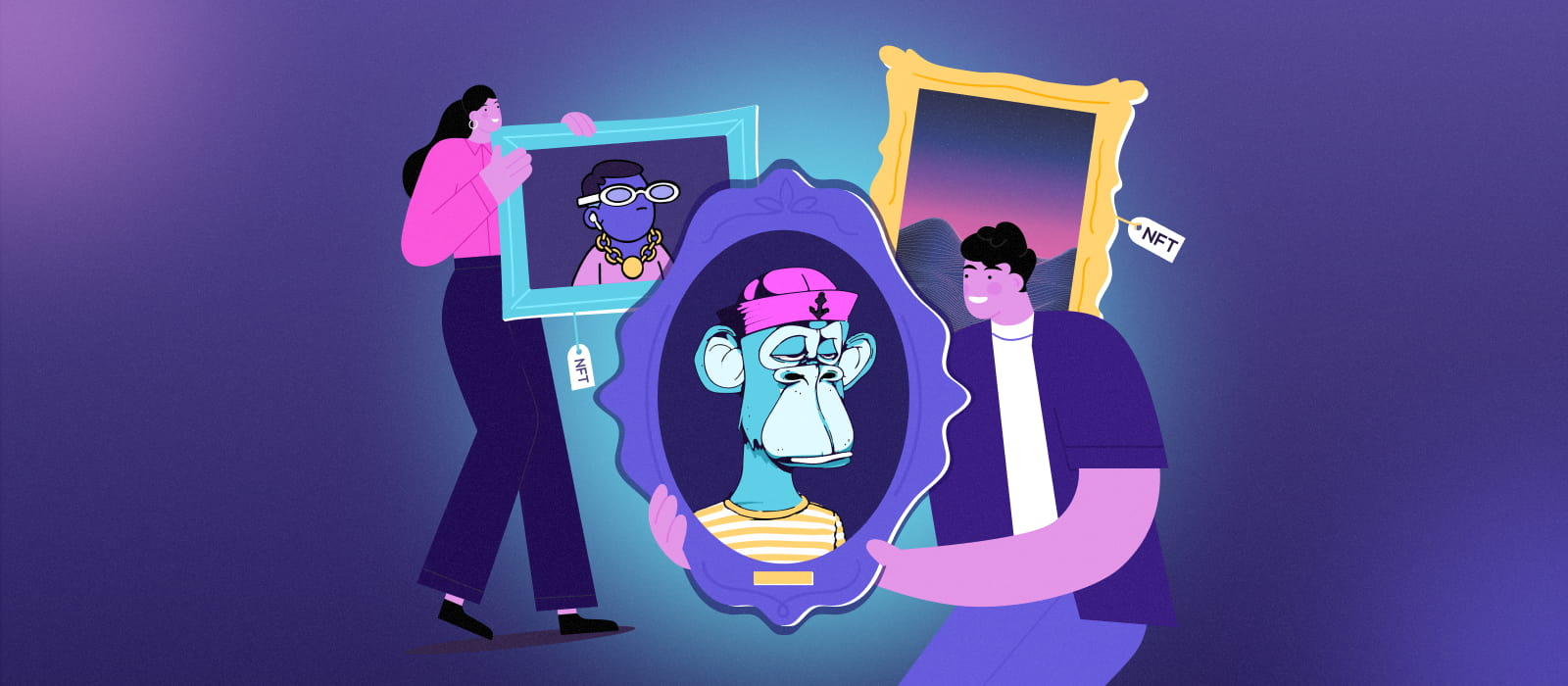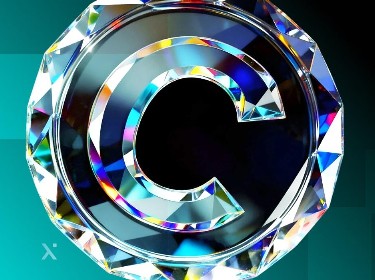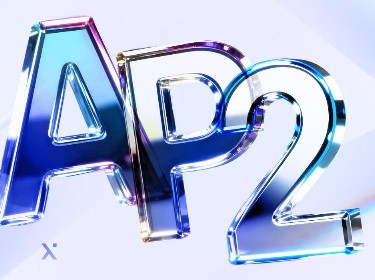If you’ve been reading the headlines about crazy sales of NFT art, you probably have a list of questions floating around your head. Is it all just hype, or should you go ahead and invest in this field? How can you actually capitalize on NFT art? And, most importantly, what does its future look like?
CryptoPunks, Bored Apes, Mutant Apes — these and many more digital collections have got people from all over the world talking about NFT crypto art. And it has borne fruit. Collections like these are selling for between $350,000 and $500,000, and in some cases can reach millions of dollars. A CryptoPunk alien was recently purchased for $11.7 million.
If you are still wondering what all the commotion is about and what can explain the astonishing prices of NFT art, we will help you to understand this phenomenon. In this article we will look at the most common questions about NFT art and provide you with advice on how to capitalize on this trend.
What is NFT art and are NFTs a new form of art?
NFT art, also known as crypto art, represents digital goods such as illustration, video, or music that are tokenized via blockchain technology. Unlike traditional art, it exists in the form of non-fungible tokens — unique digital assets that link ownership to unique physical and digital items.
Recorded on the blockchain, NFTs provide users with a certificate of authenticity while dealing with those many issues common to the art industry, such as privacy, copyright infringement, and intellectual property. NFTs can be minted (registered on the blockchain) from almost anything, whether it’s a traditional artwork or even a tweet. This means it’s bringing a host of opportunities for the art industry.
But can we say that NFTs are a new type of art? Not really. You should treat them as instruments that help prove that the owned file is authentic, and that also create scarcity. You can mint traditional art as NFTs, but in this case your NFT won’t be a new piece of art. Instead, it will create a digital bundle of secure data about that piece of art as well as a record of its ownership and data on how much money and royalties should go to the artist when it is resold.
Want to know more about how NFTs can be used, especially in areas like fashion, retail, and e-commerce? Watch this video to explore these use cases in detail and see real-life examples.
So, what makes NFT art valuable on the market? Outline of key benefits
First of all, NFTs help address the issues of provenance and authenticity. When an artist creates an NFT for their digital art, they create an immutable record on blockchain, which allows for certifying the art as original and unique.
But NFTs do much more than that. They create liquidity for the owners of artworks, while eliminating intermediaries and the transaction costs of buying and selling activities.
By using NFTs, artists can register their artwork and avoid plagiarism, while also monitoring their sales and collecting royalties from all transactions.
In contrast to traditional art, crypto art can be owned by multiple individuals who can trade portions of famous art pieces. This ensures democratization and enables less wealthy individuals to enter the expensive art market.
According to Hans Ulrich Obrist, an art curator, critic and historian,
“NFTs have already transformed the art world, regardless of whether the boom continues.”
NFT art market volume
The art market was one of the first markets to adopt NFTs, with people paying thousands and even millions of dollars in them. In 2021, the total NFT market surpassed $40 billion.
At present, collectible NFTs are the most popular category, followed by NFT art. As of January 2022 there were 29,315 non-fungible token sales within the space of one month.
At the same time, the NFT crypto art market is highly volatile. For example, in July 2021, the average price for a CryptoPunk image was $100,000. In November 2021, this figure rose to nearly $500,000. By December, it had fallen to $350,000.
What are the differences between NFT art and traditional art?
![]()
The main differences between NFT crypto art and traditional art largely lie in aspects such as their creation, accessibility, market manipulation, and legitimacy. Let’s take a closer look at each of these.
- Creation. Traditional art can only be created, and exist, within a single physical space, whereas NFT art is created on NFT platforms and sold on NFT marketplaces.
- Accessibility. NFT art is more accessible and doesn’t require you to visit a specific museum or gallery. All you need to do is to open up an NFT marketplace, where you can admire even the most expensive NFTs ever sold. You can then also buy the NFT art displayed on these marketplaces.
- Market manipulation. Unlike traditional art, which generally has fewer collectors, NFT art largely depends on marketing campaigns. NFT art projects need to have a good online presence to bring more fans to the selling page.
- Legitimacy. NFT crypto art is currently not as regulated as the traditional variety. Although NFTs ensure the security of all transactions, it is hard to verify the identity of the buyer or seller, which may lead to money laundering. In traditional art, this issue is eliminated through the use of physical signatures and documents.
What are the types of NFT crypto art?
Currently, there are two major types of NFT art, namely generative and non-generative artworks.
Non-generative artworks are pictures, paintings, and other artwork that people create and go on to upload as NFTs. Such artworks are the result of people’s creativity.
Most of the current NFT art that you can see on the marketplaces is non-generative. For example, “Crossroads”, a famous piece of art by Beeple that was sold for $6.6 million, is an example of non-generative art.
Generative artworks are created with the help of a specific algorithm. This algorithm leverages a unique NFT identifier to create digital artwork. Generative artworks can be created by an algorithm from start to finish.
CryptoKitties is a well-known example of generative art. These are digital cats that are generated and stored on centralized services.
Introduce yourself to xtingles — a Flow-powered NFT marketplace for ASMR artists
What do NFTs mean for creators?
NFTs are game-changers for artists and creators. They enable them not only to prove the ownership of the artwork but also provide novel ways to generate income. In 2021, the marketplace for NFTs reached a $21 billion value. By comparison, sales in the global fine art market were $50 billion in 2020.
By selling NFT crypto art on a marketplace, artists can deal with consumers directly. Content creators do not need to search for specific places where they can place their work. Instead, they can establish a global presence through popular NFT marketplaces.
But what kind of artists can actually benefit from NFTs?
NFTs bring opportunities for both popular and novice artists who try to capitalize on the hype. At the same time, it is worth saying that the market for NFT crypto art is now becoming saturated, and competition looks set to get hotter.
Currently, graphic artists are an interesting group worthy of attention. These are the people who create computer-generated imagery for video games, movies and so on. Since the sale of one of the most expensive NFT art — “Everydays: The First 5000 Days,” a collage of digital images by Beeple that was sold for $69 million — more and more graphic artists have been trying to bang on the doors of this art market.
How to create NFT art? Key steps
For those artists who want to trade NFTs on a marketplace, the main question is how to make NFT art. To do this, you should follow these six steps:
- Choose an item. Choose your custom painting, picture, meme or whatever it is that you want to turn into an NFT. You should own intellectual property rights to this item.
- Select a blockchain. Choose the blockchain technology you will use to mint your NFT crypto art. Most artists use the Ethereum blockchain. Other popular platforms include Polkadot, Tezos, Solana and Flow.
- Create a digital wallet. You will need a wallet to buy and access your digital assets. MetaMask, Trust Wallet, AlphaWallet and Coinbase Wallet are currently the most popular wallets on the market.
- Choose an NFT marketplace. You’ll need to join an NFT art marketplace to create and sell your art NFTs. Most artists trade on the OpenSea marketplace, but the most popular alternatives are Rarible, Nifty Gateway and SuperRare.
- Mint your NFT. Upload your digital file (as a PNG, a GIF, or in other format) to the NFT marketplace of your choice. The marketplace should have a step-by-step guide on how to do it. This will enable you to create a marketable NFT.
- Set up the sale process. How to sell NFT art when everything is settled? Set a fixed price or a starting price (if it is an auction sale) for your NFT artwork and add a description. Then, you’ll need to set up a timed auction — a time period during which interested parties can submit their final bid. As an alternative, you can also set an unlimited auction — an auction which you can end whenever you want.
Take a look at this article to learn which blockchain will suit best for your future project
How are NFTs used in the art market?
![]()
NFTs provide ample opportunities for creators, art enthusiasts and anyone who wants to sell and buy NFT art. NFTs push forward the development of digital collectibles, underpin new revenue streams, offer new ways to store art, and help increase brand awareness.
Let’s discuss each of these applications in detail.
New ways to store NFT art
Physical works of art generally require special storage facilities, including lighting and temperature conditions. As a result, museums and art galleries spend millions of dollars on storing valuable artworks. In some cases, these measures are still not enough: art objects eventually degrade and no longer look the way they did originally.
NFTs help eliminate these problems by digitizing physical art objects while preserving their value.
Moreover, NFTs have given birth to the development of metaverse virtual museums that can be accessed by anyone, anytime. Dmitry Ozerkov, the head of the contemporary art department at the State Hermitage Museum, predicts that museums all over the world will build metaverse copies making use of non-fungible tokens. According to Ozerkov,
“We are all moving into the digital era and our digital twin will be following us everywhere.”
New monetization opportunities
NFTs bring useful revenue streams for artists who create and sell their digital art on NFT art marketplaces. By directly selling their NFTs to buyers and thus bypassing intermediaries, artists can significantly increase their cash flow.
Some NFT marketplaces pay royalties to artists when their work is resold. For example, the Foundation marketplace offers a 10% royalty on every resale of the artist’s work. It is deposited directly into the wallet of a person who minted the NFT.
Non-fungible tokens are increasingly used by museums, which is leading to the development of NFT museum eCommerce. Recently, the Uffizi Gallery in Florence turned Michelangelo’s “Doni Tondo” into an NFT and sold it for $170,000. Uffizi’s director, Eike Schmidt, says that a dozen of other major works from the museum’s collection, including Botticelli’s “The Birth of Venus” and Raphael’s “Madonna del Granduca”, will be turned into digital artworks.
Brand awareness
Being able to represent a variety of items, from a sketch to a piece of artwork, NFTs allow artists and creators to increase the number of users interacting with their work. For artists, there’s no longer a need to search for places that can store their artwork. With NFT art marketplaces, even the lesser-known artists have an opportunity to reach a large audience.
Strategic collaborations also present a great opportunity for artists to create brand awareness and promote their works. NFT artists can partner with famous brands and art creators to expand their audience reach. For example, the collaboration of RTFKT studios, a virtual sneaker brand, with FEWOCiOUS, an 18-year old crypto-artist, resulted in $3.1 million raised in seven minutes.
Are art NFTs a good investment?
Investing in NFT crypto art has its pros and cons. On the one hand, due to the volatility of this market, NFT art can be a risky investment. The market continues to evolve rapidly and is still largely unregulated, which often results in NFT art coin price fluctuations.
At the same time, there are plenty of examples of relatively small investments that resulted in big returns. In 2019 Trevor Jones, a traditional artist who moved into crypto art, sold his first NFT piece, EthGirl, for 70 Ether. It was the equivalent to $10,000 at that time. Two years later, Jones’ artwork was valued at over $8 million.
As the NFT community of collectors and investors grows over time, the result will be an increase in demand. And as more artists choose NFT art as a better option for their artwork, the supply ratchets up as well.
Clearly, the NFT market does present some interesting opportunities for investors. But before making a decision, you should do your own research on the NFT project you want to invest in by analyzing its history of transactions, the community behind the project, and more besides.
There are numerous tools on the market that help you decide on whether or not to invest in a specific NFT project. One of these offerings is CheckNFT — a solution that analyzes the value of NFT collections and provides users with actionable insights. Alternatively, you can turn to the platforms that offer rankings and analyses for NFT collections, such as DappRadar.
Check out this article to discover some of the most promising NFT use cases across industries
NFT art market risks and limitations you should be aware of
![]()
Everything in life has its benefits and drawbacks, and NFT art is no exception. Currently, the main risks and limitations associated with NFT art include scams, a hefty ecological footprint, legal and regulatory risks, and subjectivity in judging the quality of NFT art.
Let’s dive deeper into each of these points
NFT scams
Although one of the advantages of NFTs is their ability to provide proof of ownership, this does nothing to stop people from minting an NFT of an artwork that they didn’t create.
Legally, before minting an NFT it is necessary to get permission from a copyright holder. But not all platforms require such proof, and fraudulent activity is the result.
An interesting case occurred in 2021 when a hacker sold a fake Banksy artwork as an NFT using the artist’s own website. The artwork was sold for $366,000. Although this is an extreme example of NFT scamming, not unlike instances of traditional art forgeries, it still poses a question over the value of NFT.
Hefty ecological footprint
Being based on blockchain, NFTs consume a lot of energy. Most creators mint NFTs through Ethereum — a proof-of-work-powered platform. Ethereum consumes 111.63 TWh, which is comparable to the annual power consumption of the Netherlands. And the growing demand for digital art will only increase Ethereum’s total.
Joanie Lemercier, a French digital artist, recently canceled the sale of his six works after calculating the associated energy consumption. Lemercier estimated that in just 10 seconds the process would use an amount of electricity capable of powering the artist’s entire studio for two years.
Luckily, there are already alternative solutions on the market and many developers around the world continue to work towards the production of green blockchains. Some of the eco-friendly alternatives include Cardano, Solana, Algorand, WAX, and Tezos.
Legal and regulatory risks
NFTs are commonly associated with regulatory concerns. Unfortunately, the existing regulatory environment was not designed to accommodate digital assets. Some legal experts believe that NFTs should be regulated under federal law, while others warn that many other regulations may be implicated.
The main issue in establishing a regulatory framework for NFTs is the difficulty in classifying these assets. For example, if NFTs are deemed to be commodities, then the Commodity Exchange Act may be implicated, and if NFTs are deemed to be antiquities this may trigger anti-money laundering laws. Security laws may also be applied if NFTs are considered securities.
NFT intellectual property rights is another interesting angle to consider. When purchasing an NFT, you must make sure that the seller actually owns that NFT. The seller may have a replica instead of an actual painting. This means that if you buy this NFT, you will receive the right to use it but not the intellectual property rights.
So, before purchasing an NFT, you should go through the metadata of the smart contract and check if it has terms and conditions of ownership.
Take a look at this article to learn useful insights on NFT marketplace vulnerabilities
Subjectivity in judging the quality of NFT art
As with traditional art, there is always a degree of subjectivity when it comes to judging the quality of digital art. If we take the example of Beeple’s most expensive NFT artwork, there is no doubt that the bidders liked it. At the same time, they wanted to whip up publicity for NFTs, which they did very well and which explains the astonishing price of Beeple’s work.
In their podcast interview with Zwirner, Beeple touched on this question, saying that casual users may not always realize that it can be very complicated to use software to create something small and simple on a computer.
Beeple is virtuous in its aims, and all NFT art enthusiasts clearly understand this. But there are also certain other valuable and expensive works by artists such as Cy Twombly which, according to digital art critics, were created quickly and with little evident skill. This brings us back to the issue of subjectivity of digital art.
What are the most popular NFT art examples?
The NFT art market has given us a wide range of NFT artists and fascinating projects, so let’s take a quick look at the most popular ones.
Hashmasks
Hashmasks is a virtual art gallery collection on the Ethereum platform. The collection stores more than 16,000 unique digital portraits created by 70 artists from around the world. Hashmasks allows buyers to customize their portraits based on character type — changing, for example, mask style or eye color.
BREAKFAST
BREAKFAST is an art studio known for its kinetic art installations. It makes use of interactive displays, which enable onlookers to become a part of art. They turned their physical kinetic artwork, Longyearbyen Warming, into an NFT with the goal of increasing awareness of climate change.
Bored Ape Yacht Club
Bored Ape Yacht Club is an Ethereum-based collection of more than 10,000 collectible ape characters. Each NFT in the collection is unique and created from over 170 possible traits, such as clothing, facial expressions and more. The most expensive Bored Apes NFT was sold for 740 ETH, which is equivalent to $2.99 million.
Cool Cats
Cool Cats is another Ethereum-based NFT art collection hitting the headlines. It comprises 9,999 unique items that are presented as blue cat animations. One of the coolest things about this project is that it allows developers to breed the characters to create future generations. One of the project’s highest prices was secured by a special edition Zombie Cool Cat. It was sold for 320 ETH ($1.1 million).
CryptoPunks
Obviously, this list wouldn’t be complete without CryptoPunks — one of the earliest examples of NFTs, created by Larva Labs. The collection stores 10,000 unique pixel art characters, most of them looking like punkish humans. That said, there are also other characters such as zombies, apes and aliens.
Will we see NFT art in the metaverse?
In light of the growing popularity of the metaverse, the big question concerns the potential of art to make its mark in this new virtual space.
The metaverse can undoubtedly offer a more immersive experience to art enthusiasts and lead to the development of virtual art galleries, exhibitions and museums. Many artists will likely follow the trend and start showcasing their artworks in groundbreaking ways.
Some key players have already started experimenting with using virtual spaces for the visual arts. For instance, Sotheby’s, a multinational corporation and a premier destination for auctions and private sales of fine art, recently announced the launch of Sotheby’s Metaverse. It’s a new platform that features NFTs built specifically for digital collectors.
Sotheby’s Metaverse offers multiple payment options, including various cryptocurrencies and fiat money. To date, they have sold more than $70 million of NFT digital art.
If you’re not sure what the metaverse is all about we recommend you take a look at our recent article
How can your business capitalize on NFT art?
![]()
If you are planning to take your first steps towards NFT art, or want to extend your business presence with NFTs, we recommend you consider one of the options below.
Create and sell NFT art
If you own physical or digital pieces of art, or want to create works from scratch, then the best way to monetize them will be to sell your works on secondary marketplaces like OpenSea or Rarible.
Keep in mind that each future sale of your NFT earns a loyalty income for the original creator. This way you can build an unbreakable revenue stream.
Invest and trade
You can treat the NFT art market in a similar way to the stock market or cryptocurrency market.
Analyze the existing NFT art projects, choose the promising ones (based on market insights and/or data from analytics platforms), wait for value appreciation, and trade your NFTs.
Launch your marketplace
Booming demand for NFTs is leading to greater demand for NFT marketplaces. Therefore, an excellent way to capitalize on the popularity of NFTs will be to partner an NFT art marketplace development company and develop a marketplace.
There are some important things to consider when launching the NFT marketplace:
- First, choose the platform which will be the basis for your marketplace. We recommend you pay attention to factors such as scalability, sustainability and cost of transactions
- Ensure the security of your marketplace by enabling two-factor authentication and educating your users on security measures
- Make sure that your marketplace has an intuitive user interface and has features such as easy browsing by categories, search filters, rankings, unlockable content, wallet integration, and favorites.
Meet Savage — a first-of-its-kind NFT marketplace for minting and selling video clips
What does the future of NFT art look like?
Judging by the expanding popularity of art NFTs, alongside numerous successful projects and marketplaces, as well as advances in the metaverse domain, we can conclude that the future for NFT art looks bright.
NFTs provide an array of possibilities for creators, investors, business owners and art enthusiasts. Despite some legal and regulatory concerns, new NFT projects continually appear, so the current NFT art craze doesn’t show any signs of ending.
Whether you need advice on how to capitalize on NFT art, or want to implement NFT token development services to turn your idea into real-life profit, we’re here to help. We’ve already assisted multiple NFT enthusiasts and businesses in their NFT initiatives and will be happy to turn your brilliant ideas into successful projects.




